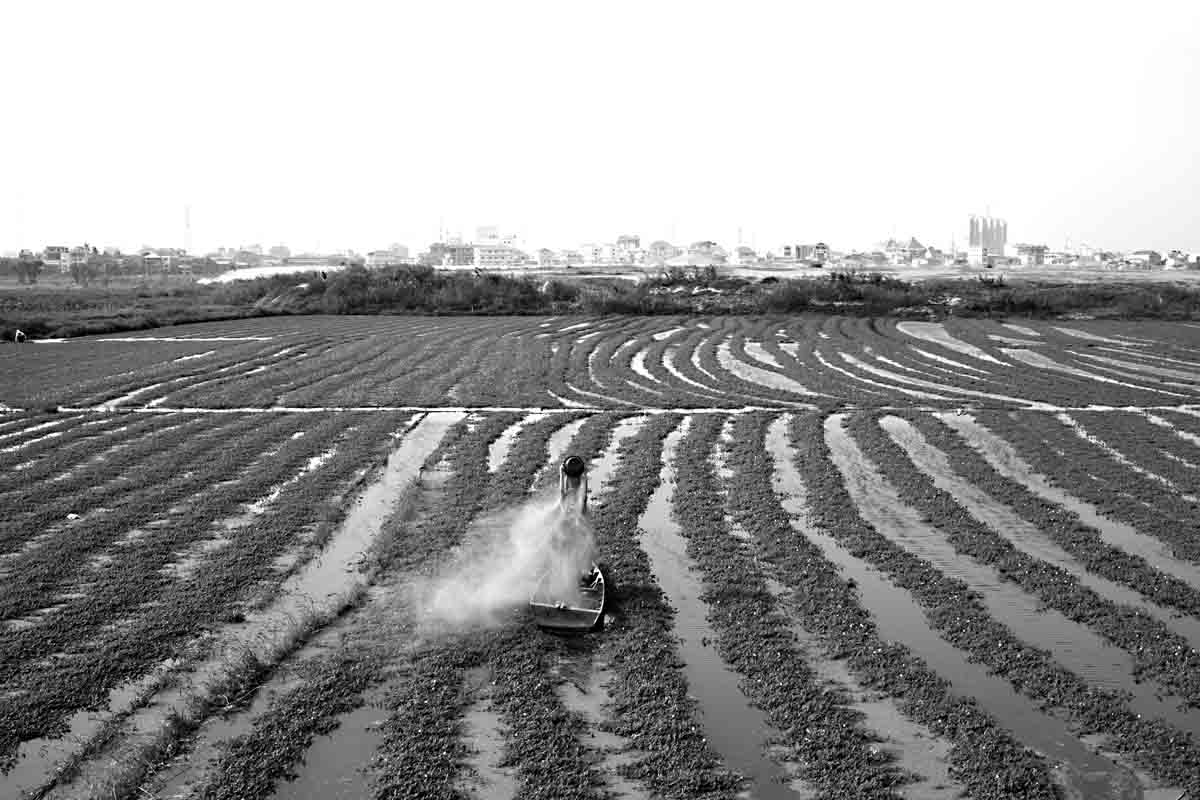Khvay Samnang used to sell his paintings at the market for $15 apiece. Now, favouring the camera lens over the paintbrush, he’s forging a reputation in the international art world – although his focus remains firmly at home.
Untitled, a series of photographs of the artist standing in a downpour of sand half-submerged in lakes, evinces Khvay’s humanitarian and environmental concerns. Untitled uses an invented language of gesture to predicate the impending event of development on land where immense lakes now sit. We are mostly aware of these development plans, but Khvay’s exposition of the anticipated change inspires the sort of reaction no news report can.
A news report is a commentary, which Khvay is determined Untitled is not. Untitled is a parody – a serious parody – which exists prior to the event. It’s a cipher: encrypting the event in a language of gesture, while decrypting it by rendering the event in simple terms, all without the help (or hindrance) of the written or spoken word.
Oddly, the seriousness of the consequences of such development is only accessible in this form. Khay’s is an intimate parody, which seems to say ‘This is too much,’ rather than asserting how it is. It bespeaks the unnarratable, but the language of gesture is understandable. It functions to illuminate the condition and it is beautiful in its simplicity.
This month, Khvay will show a documentary film which accompanies Untitled in the group show New Artefacts at Sa Sa Bassac Gallery. This film has never been shown before because, up until now, Khvay hasn’t found an appropriate platform for it.
“When I exhibited Untitled in 2011, I included one video with the photographs. I wanted to have more video, but I felt the documentary video was fighting with the photographs. The documentary is the opposite from the photographs. I would have liked to show them all together but the contrast made me decide to show together with only the video of the dropping sand, not a documentary video. When Roger (Nelson, curator) talked with me about the idea for New Artefacts, I feel like ‘Oh my God, I have the video!’”
Khvay’s urge to record his process bespeaks a natural drive to document. It’s a form of savouring the temporary: that which is threatened, which is the landscape itself, but also the instantaneous nature of the photograph, without context. He seems to establish another base on which his vision can stand.
The documentary reveals a new ‘truth’: the truth of Khvay’s creative experience. “In the video you can see the local people keeping busy working but still looking. I didn’t ask them what they think about my work because I think maybe the security is coming, so I needed to hurry up.” The video highlights the individuality of the locals, some of whom feature in the photographs, but appear as potential subjects of the images’ aesthetic.
Another conflict between photograph and video occurs on the site of Khvay’s body. The photographs evince Chinese contemporary arts pioneer Wang Jianwei’s notion that “the artist as an individual participates in the process and eliminates his personal power so as to eliminate all desire for self-expression” as a completed process by the time the photograph is taken.
The video demonstrates the process of that elimination. Khvay wading into the water is an experience which centres more on the individual’s struggle towards achieving his vision, eliciting moments of disgust and compassion. It is as though during the walk towards the point at which Khvay will be photographed, he is shedding his self-expression, his corporeal skin, to become the gesturing figure, the symbol of the drowned.
WHO: Khvay Samnang
WHAT: Untitled documentary and photography exhibition
WHERE: Sa Sa Bassac Gallery, #18 2nd Floor, Sothearos Blvd.
WHEN: August
WHY: An intimate parody of development
